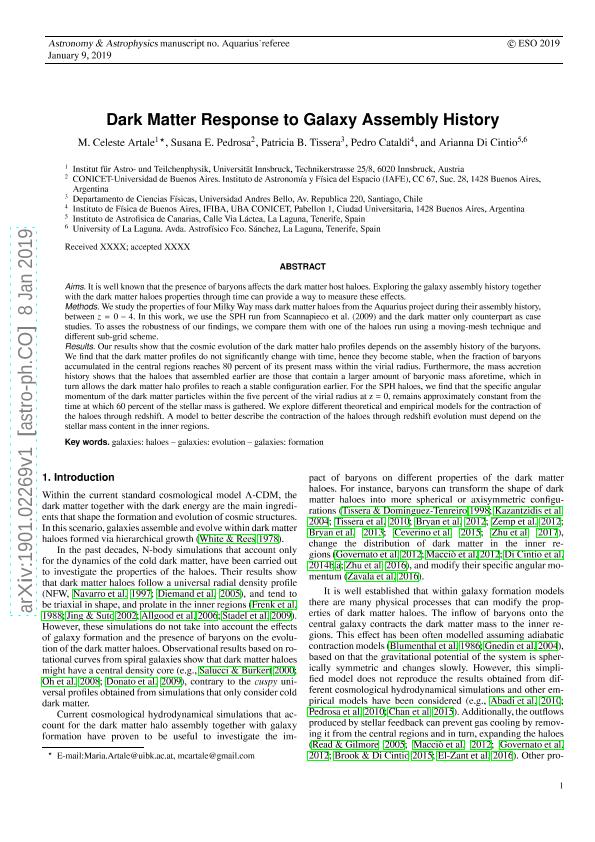Mostrar el registro sencillo del ítem
dc.contributor.author
Artale, María Celeste
dc.contributor.author
Pedrosa, Susana Elizabeth

dc.contributor.author
Tissera, Patricia Beatriz

dc.contributor.author
Cataldi, Pedro Anselmo

dc.contributor.author
Di Cintio, Arianna
dc.date.available
2022-02-11T02:29:07Z
dc.date.issued
2019-02
dc.identifier.citation
Artale, María Celeste; Pedrosa, Susana Elizabeth; Tissera, Patricia Beatriz; Cataldi, Pedro Anselmo; Di Cintio, Arianna; Dark matter response to galaxy assembly history; EDP Sciences; Astronomy and Astrophysics; 622; A197; 2-2019; 1-17
dc.identifier.issn
0004-6361
dc.identifier.uri
http://hdl.handle.net/11336/151826
dc.description.abstract
Aims. It is well known that the presence of baryons affects the dark matter host haloes. Exploring the galaxy assembly history together with the dark matter haloes properties through time can provide a way to measure these effects. Methods. We study the properties of four Milky Way mass dark matter haloes from the Aquarius project during their assembly history, between z = 0 − 4. In this work, we use the SPH run from Scannapieco et al. (2009) and the dark matter only counterpart as case studies. To asses the robustness of our findings, we compare them with one of the haloes run using a moving-mesh technique and different sub-grid scheme. Results. Our results show that the cosmic evolution of the dark matter halo profiles depends on the assembly history of the baryons. We find that the dark matter profiles do not significantly change with time, hence they become stable, when the fraction of baryons accumulated in the central regions reaches 80 percent of its present mass within the virial radius. Furthermore, the mass accretion history shows that the haloes that assembled earlier are those that contain a larger amount of baryonic mass aforetime, which in turn allows the dark matter halo profiles to reach a stable configuration earlier. For the SPH haloes, we find that the specific angular momentum of the dark matter particles within the five percent of the virial radius at z = 0, remains approximately constant from the time at which 60 percent of the stellar mass is gathered. We explore different theoretical and empirical models for the contraction of the haloes through redshift. A model to better describe the contraction of the haloes through redshift evolution must depend on the stellar mass content in the inner regions.
dc.format
application/pdf
dc.language.iso
eng
dc.publisher
EDP Sciences

dc.rights
info:eu-repo/semantics/openAccess
dc.rights.uri
https://creativecommons.org/licenses/by-nc-sa/2.5/ar/
dc.subject
GALAXIES: HALOS
dc.subject
GALAXY: EVOLUTION
dc.subject
GALAXY: FORMATION
dc.subject.classification
Astronomía

dc.subject.classification
Ciencias Físicas

dc.subject.classification
CIENCIAS NATURALES Y EXACTAS

dc.title
Dark matter response to galaxy assembly history
dc.type
info:eu-repo/semantics/article
dc.type
info:ar-repo/semantics/artículo
dc.type
info:eu-repo/semantics/publishedVersion
dc.date.updated
2021-01-18T15:02:11Z
dc.journal.volume
622
dc.journal.number
A197
dc.journal.pagination
1-17
dc.journal.pais
Francia

dc.journal.ciudad
Paris
dc.description.fil
Fil: Artale, María Celeste. Universidad de Innsbruck; Austria
dc.description.fil
Fil: Pedrosa, Susana Elizabeth. Consejo Nacional de Investigaciónes Científicas y Técnicas. Oficina de Coordinación Administrativa Ciudad Universitaria. Instituto de Astronomía y Física del Espacio. - Universidad de Buenos Aires. Facultad de Ciencias Exactas y Naturales. Instituto de Astronomía y Física del Espacio; Argentina
dc.description.fil
Fil: Tissera, Patricia Beatriz. Consejo Nacional de Investigaciónes Científicas y Técnicas. Oficina de Coordinación Administrativa Ciudad Universitaria. Instituto de Astronomía y Física del Espacio. - Universidad de Buenos Aires. Facultad de Ciencias Exactas y Naturales. Instituto de Astronomía y Física del Espacio; Argentina. Universidad Andrés Bello; Chile
dc.description.fil
Fil: Cataldi, Pedro Anselmo. Consejo Nacional de Investigaciones Científicas y Técnicas. Oficina de Coordinación Administrativa Ciudad Universitaria. Instituto de Física de Buenos Aires. Universidad de Buenos Aires. Facultad de Ciencias Exactas y Naturales. Instituto de Física de Buenos Aires; Argentina
dc.description.fil
Fil: Di Cintio, Arianna. Universidad de La Laguna; España. Instituto de Astrofísica de Canarias; España
dc.journal.title
Astronomy and Astrophysics

dc.relation.alternativeid
info:eu-repo/semantics/altIdentifier/doi/http://dx.doi.org/10.1051/0004-6361/201834096
dc.relation.alternativeid
info:eu-repo/semantics/altIdentifier/url/https://arxiv.org/abs/1901.02269v1
dc.relation.alternativeid
info:eu-repo/semantics/altIdentifier/url/https://www.aanda.org/articles/aa/full_html/2019/02/aa34096-18/aa34096-18.html
Archivos asociados
